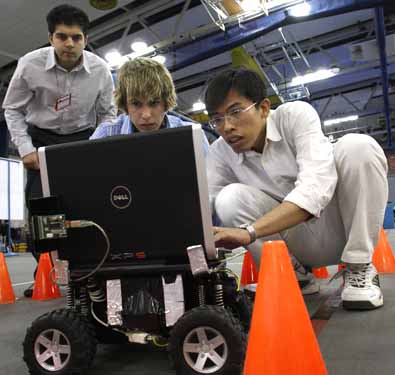(Date Added: 2008-05-29 16:57:53. Local cache.)
Summary
Overcoming alternating bright sunlight and thunderstorms, camera flashes and students in red uniforms, a team from the University of Windsor recently
Dave Hall, Windsor Star
Overcoming alternating bright sunlight and thunderstorms, camera flashes and students in red uniforms, a team from the University of Windsor recently won the National Autonomous Racing Challenge in Waterloo.
Now displaying its technology at the annual Canadian Conference on Intelligent Systems at the university's St. Denis Centre, the team overcame a variety of setbacks to capture the championship.
Project co-ordinator Siddhant Ahuja said "after what we went through from blown batteries, short circuits and malfunctioning cameras, I'm surprised we won but it taught us that technology developed under lab conditions has to be adaptable to the real world."

'EXTREME CONDITIONS': Members of Team Invincible - Ehsan Paruizi, left, Michael Stolarchuk and Thanh Nguyen - make adjustments to their autonomous robot. The team, part of the U of W's Computer Vision and Sensing Systems Laboratory, won the Autonomous Racing Challenge in Waterloo earlier this year. Photograph by : Pawel Dwulit, Windsor Star
In addition to flashing cameras, which damaged pixels in the camera used to guide the model vehicle, changing lighting conditions which also played havoc with the camera, the vehicle, which was programmed to race between orange-coloured pylons, also reacted to students wearing similarly-coloured jackets.
And before racing even began, the Windsor team had to enlist the help of maintenance staff from the University of Waterloo to clear a practice area which they used until 3 a.m. before returning for the competition.
"Under extreme conditions, we learned a great deal about the practical application of our technology," said Ahuja, who led a team which included Thanh Nguyen, Ehsan Parvizi, Bahador Khaleghi and Mike Stolarchuk, a Grade 11 student from Belle River high school.
Using cameras, sensors and complicated 3-D tracking programs, the vehicle was able to navigate a course set by pylons without any human guidance.
Developed by the vision and sensing systems laboratory, the vehicle had to navigate a drag-racing course, pass a round of static judging on looks and design and then complete a street-racing circuit which it did in a record one minute and 45 seconds.
Facing teams of up to 70 members with budgets ranging as high as $60,000, the Windsor team, which included faculty adviser Jonathan Wu, was funded by a $1,000 donation from BASF and a $500 department grant
Among the vehicle's practical applications are a drowsy driver detection system, pedestrian detection and tracking, collision warning and avoidance systems, parking assistance, vehicle navigation, traffic monitoring, blind spot detection, lane departure warnings and obstacle detection and avoidance.
Stolarchuk, whose mother Lorie works at the university, said he first became involved with the electrical and computer engineering department five years ago when he was just 12.
"I'd always liked electrical systems from when I was just a youngster and I jumped at the chance to work on something like this," said Stolarchuk who was largely responsible for the project's mechanical wiring and design systems.
